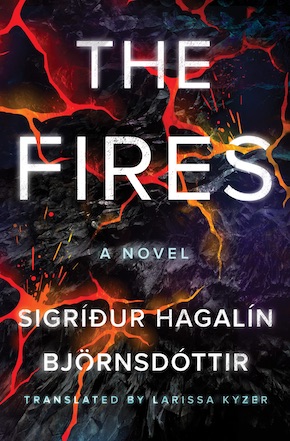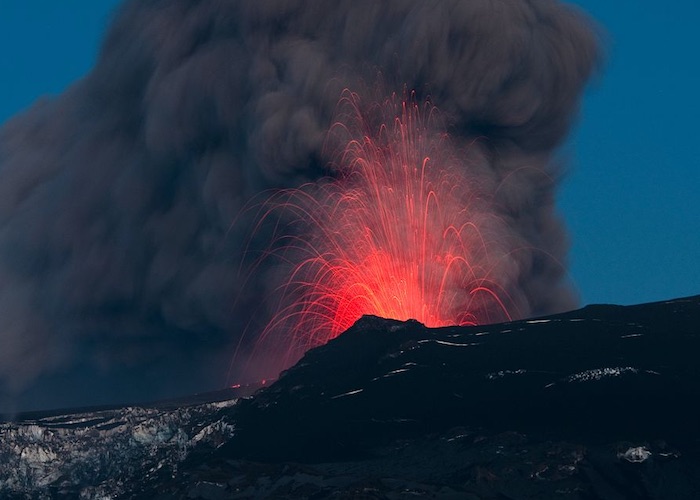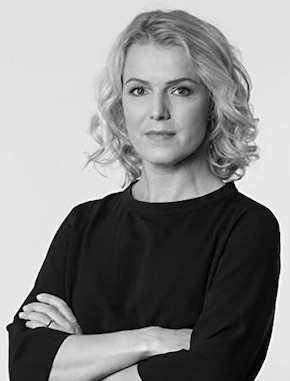Into the volcano
by Sigríður Hagalín Björnsdóttir
In Iceland, volcanoes used to be a menace; terrible, sleeping monsters that erupted once in a while, spewing ash and lava over the country, killing people and animals, destroying homes and causing famines. Today, thanks to science, we know much more about them, we understand why they erupt, and our brilliant geoscientists can often warn us before they go off. So instead of being afraid of them, Icelanders have grown to love their volcanoes, we name our children after them. And when they erupt, everybody tries to go there and see them – which is really not a very good idea, because eruptions can be very dangerous and unpredictable. But we just love them. And I have to say that witnessing a real volcanic eruption is otherworldly, it‘s a life-changing experience to watch the earth being born.
In 1783–4, an enormous volcanic eruption in Laki killed more than one fifth of the population, leaving Iceland so ravaged that there were plans to evacuate and replace all the survivors in Denmark. Fortunately, nothing came of it, as otherwise there would be no such thing as contemporary Icelandic literature. But the volcanic fumes and ash blew over Europe, damaging harvests and probably contributing to the inflation revolts that led to the French Revolution. So volcanic activity may have shaped much more than just Icelandic identity.
In 1973, the fishing community in the Westman Islands woke up to find that their small, local mountain had cracked open and turned into a fiery inferno, and that the lava was devouring some of their houses and the local church. By some stroke of luck, all the fishing boats were in the harbour, as the weather was too bad for fishing, so all 5,000 inhabitants were evacuated to the mainland that night. After the initial shock, people began planning how to rescue as much as they could from the lava, including the harbour, which was vital for the town’s survival. Eventually, a gang of scientists came up with a method to pump seawater onto the edge of the lava to cool it and redirect its flow, so the harbour was saved. It was the first time that we know of that human ingenuity prevailed over the destructive forces of the volcano. The islanders returned after the eruption and the town went back to unexcitingly normal.
When Eyjafjallajökull, the unpronounceable volcano in the south, erupted in 2010, we thought all was lost. The country was in an economic and moral shambles after the collapse of our banking system in 2008, when thousands of Europeans lost their life savings in the criminally mismanaged Icelandic banks, and now a sub-glacial volcanic outbreak was adding insult to injury, puffing ash into the stratosphere, closing the airways over the Atlantic Ocean, isolating us on our damp, gloomy island and would probably make everyone hate us even more. But we were wrong. The eruption sparked an enormous interest in Iceland, making the country one of the most popular tourist destinations in Europe, and creating the foundations of a new industry. Tourism boomed and became the most valuable industry in Iceland in very few years, and this new bonanza was almost entirely powered by the country‘s image as a wild, volcanic natural wonder. In that way, our love for volcanic outbreaks became our most important export, and saved the economy. And the volcanoes paid back their debt from 1783, which is much more than you could ever say of the Icelandic bankers.
We are, whether we like it or not, a part of the natural world, and our bodies and minds and our hearts are just as natural as a volcano, or a jungle, or a school of fish.”

Volcanic eruptions are an easy inspiration, beautiful, dramatic and dangerous. I have always loved covering them as a journalist, and when I began working on The Fires, I also found inspiration in poetry on one hand, and in scientific sources on the other. There is a wonderful culture of storytelling and crisp, imaginative writing in the Icelandic geoscientific community, and I felt that I had hit a goldmine talking to scientists and reading their texts.
There is a tradition of volcanic fiction in Iceland, most of it historical novels, written by men. Women haven’t written that much about them, and none that I know of have written about future eruptions. But I was interested in exploring the sleeping volcano and the eruption as powerful metaphors for an emotional and erotic awakening, for the hidden power of the female body, for birth, for the constant battle between our intellect and our urges, for the cataclysmic and formidable power of love.
We are, whether we like it or not, a part of the natural world, and our bodies and minds and our hearts are just as natural as a volcano, or a jungle, or a school of fish. The human imagination is one of the wonders of nature, our most powerful weapon and tool for survival. So much of our reality is created by our imagination, including our self-image, how we perceive ourselves. In The Fires, Anna is convinced of her own good sense, her scientific infallibility and her status beyond and above nature, as Western culture has grown accustomed to regarding itself ever since the Enlightenment. Her denial of her emotions and her creative, imaginative side become the cause of her ruin, she is blindsided by her own heart.
In the novel, an eruption takes place along the Reykjavik peninsula. A few months after publication in Iceland, an eerily similar eruption took place. I have been constantly surprised, ever since I began writing fiction, by how figments of my wildest imagination have a tendency to become real. Characters turn out to be real people, experiencing the same crises and conundrums as the plots of books, or, in this case, a volcanic eruption starts just a few kilometres away from the eruption in The Fires, after an 800-year hiatus. My only honest answer to this is that books tend to know much more than the people who write them, and that throughout the ages, bards and poets and novelists have been tapping into something that they don‘t fully understand. Fiction is a dangerous business.
—

Sigríður Hagalín Björnsdóttir studied history in Reykjavík and Salamanca and journalism at Columbia University in New York and previously worked in Copenhagen before moving back to Reykjavík, where she lives with her husband, children and stepchildren. Her bestselling debut Island was nominated for the Icelandic Women’s Literature Prize in 2017. When she isn’t writing, Sigríður works as a journalist and television news anchor at the Icelandic National Broadcasting Service. Her third novel The Fires, a bestseller and viral hit in Iceland, is published by Amazon Crossing, translated by Larissa Kyzer.
Read more
@siggahagalin
@AmazonPub
Larissa Kyzer is a translator, writer and editorial professional based in Brooklyn. She holds a BA in Comparative Literature, an MS in Library and Information Science and an MA in Translation Studies, which she earned at the University of Iceland. She was awarded the American-Scandinavian Foundation’s Nadia Christensen Translation Prize for her translation of Kristín Eiríksdóttir’s Nordic Council Literature Prize-nominated A Fist or a Heart (2019), and has taught translation workshops to undergraduate and graduate students at Princeton and New York University.
larissakyzer.com
instagram.com/larissa.kyzer

